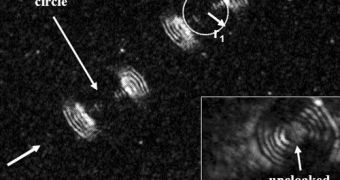Magic has turned into reality. A remarkable achievement has been made by an American team: the world's first real invisibility cloak, a device turning an object invisible in the visible spectrum. But don't get your hopes up: the technique works only in two dimensions and on a tiny scale so far.
The new cloak is only 10 micrometres wide and heads light waves around an object located inside, releasing them on the other side. The light's trajectory seems right, so the cloak and objects inside become invisible.
The new cloak is based on the first theoretical design for an invisibility cloak of Vladimir Shalaev from Purdue University, West Lafayette, Indiana, US, published in 2007. In 2006, an American-British team made an invisibility cloak functioning in the microwave area of the electromagnetic spectrum. But by 2006, a cloak in the visible spectrum was believed to be years away.
"At optical frequencies, [wavelengths] get very tiny, and the range of properties available from materials is limited," said John Pendry, a physicist at Imperial College London, and part of the 2006 research.
But the new research focused on two dimensions.
"The new cloak doesn't control the light you can see directly. It's not the invisibility most people would imagine," explained Ulf Leonhardt, a physicist at the University of St Andrews, UK.
The team at the University of Maryland, led by Igor Smolyaninov, injected polarized cyan light into a gold surface employing a minute optical fiber with a fine tip. The light waves turn into surface plasmons, waving through the electrons of the gold surface in two dimensions.
"Three-dimensional invisibility cloaks would have to control light waves both magnetically and electronically to steer them around the hidden object. But two-dimensional surface plasmons are easier to direct. You can operate on either the electric or magnetic channel alone," said Pendry.
The new cloak is made of a two-dimensional pattern of concentric gold rings wrapped in a polymethyl methacrylate plastic. The plastic and the gold possess different refractive values and bend plasmons in various directions and by varying the metal and plastic combination in the cloak, the Matyland team can maneuver plasmons with enough efficiency to head them around the cloak, like water in river flowing around a rock.
"It is unlikely that the cloak is perfectly invisible, though," said Pendry.
The Maryland team did not mention whether plasmons can reflect off the surface of their cloak; in this case, an observer could still see it like a sheet of glass. The new cloak may not be developed into a 3-D version, but could have various applications. "It could be useful in the near future. It could be used on computer chips. You could use surface plasmons to communicate between different areas of a microchip," said Leonhardt.
"They might replace fiber optics as a way to carry signals. Light on a chip might seem more prosaic than an invisibility cloak, but in the end it might be more practically important," said Pendry.

 14 DAY TRIAL //
14 DAY TRIAL //